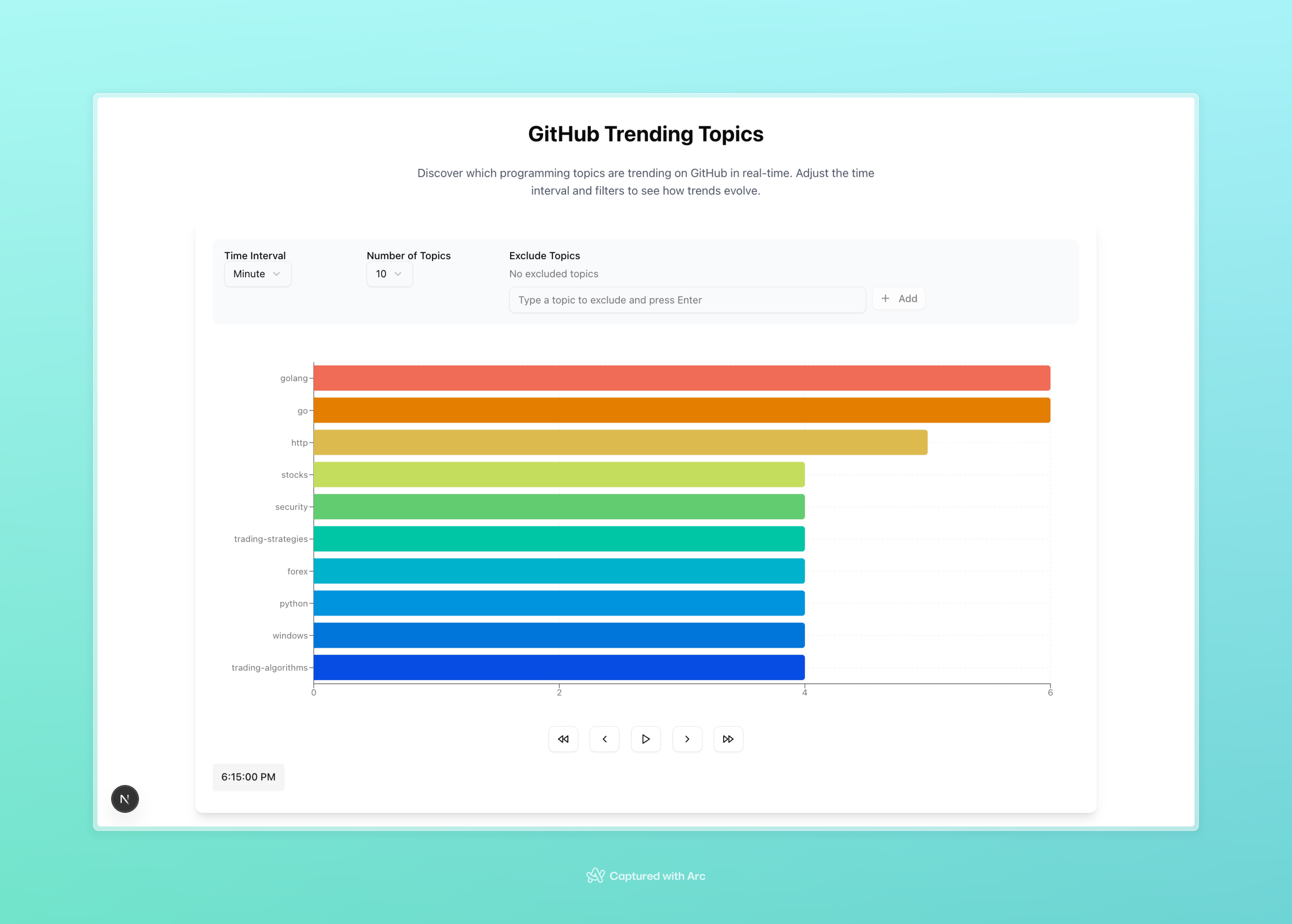Github Trending Topics

This template demonstrates how to build a real-time data pipeline and dashboard for tracking GitHub trending topics. It showcases a complete full-stack architecture that combines a Next.js frontend with a Moose backend for data ingestion, processing, and API generation.
Architecture Overview
The template implements a modern full-stack architecture with the following components:
-
Frontend Layer (Next.js)
- Real-time dashboard for trending topics
- Interactive data visualization
- Type-safe API integration with Moose Analytics APIs
- Built with TypeScript and Tailwind CSS
-
Backend Layer (Moose)
- GitHub Events data ingestion
- Real-time data processing pipeline
- Type-safe APIs with Moose Analytics APIs
- ClickHouse for analytics storage
-
Infrastructure Layer
- ClickHouse for high-performance analytics
- Redpanda for event streaming
- Temporal for workflow orchestration
- Type-safe HTTP API endpoints
Getting Started
Clone the repository:
To get started with this template, you can run the following command:
moose init moose-github-dev-trends github-dev-trendsInstall dependencies:
cd moose-github-dev-trends/moose-backend && npm installProject Structure
The template is organized into two main components:
moose-github-dev-trends/
├── dashboard/ # Frontend dashboard
│ ├── app/ # Next.js pages and routes
│ ├── components/ # React components
│ ├── generated-client/ # Auto-generated API client
│ └── lib/ # Utility functions
│
├── moose-backend/ # Backend services
│ ├── app/
│ │ ├── apis/ # Analytics API definitions
│ │ ├── ingest/ # Data ingestion logic
│ │ ├── blocks/ # Reusable processing blocks
│ │ └── scripts/ # Workflow scripts
│ └── moose.config.toml # Moose configurationRun the application
moose devWatch the polling workflow run
When you run moose dev, you’ll see the workflow run in the Moose logs.
This workflow will run a script every 60 seconds to poll GitHub for trending topics.
Scheduled Workflows
(Optional) Configure GitHub API Token
touch .envGITHUB_TOKEN=<your-github-api-key>API Rate Limits
Without authentication, you’re limited to 60 requests/hour. With a token, this increases to 5,000 requests/hour.
Development Workflow
Modern Stack
The visualization combines several modern technologies:
- Moose for type-safe API generation
- Tanstack Query for data management
- Recharts for visualization
- shadcn/ui for UI components
- Tailwind CSS for styling
The template demonstrates a complete integration between Moose and Next.js:
Moose Backend
The backend is responsible for data ingestion and API generation:
cd moose-backend && moose devKey components:
- GitHub Event Polling: Workflow in
app/scripts/fetches public events and posts them to the Moose Ingest Pipeline. - Ingest Pipeline: Data Model and infrastructure for ingesting GitHub Events in
app/ingest/WatchEvent.ts - Analytics APIs: Analytics APIs in
app/apis/expose the data for the frontend
Start the Moose Backend
Spin up the Moose dev server:
moose devThis will automatically start the workflow that polls GitHub for trending topics and ingests the data into ClickHouse.
Frontend Integration
The frontend automatically integrates with the Moose backend through generated APIs:
API Client Generation
Moose generates an OpenAPI spec from your Analytics APIs that we use with OpenAPI Generator:
- Generated client located in
live-dev-trends-dashboard/generated-client - Based on OpenAPI schema from
moose-backend/.moose/openapi.yaml
Data Flow & Visualization
The dashboard implements a modern data flow pattern using Tanstack Query and Shadcn/UI Charts:
Start the Frontend
cd dashboard && npm install && npm run devVisit http://localhost:3000 to see real-time trending topics.
Next Steps
Once you have the data flowing, you can:
- Add custom metrics and visualizations
- Implement additional GitHub data sources
- Create new API endpoints for specific analyses
- Build alerting for trending topic detection
Feel free to modify the data models, processing functions, or create new APIs to suit your specific needs!
Deployment:
Deploying this project involves deploying the Moose backend service and the frontend dashboard separately.
Prerequisites:
- A GitHub account and your project code pushed to a GitHub repository.
- A Boreal account for the backend.
- A Vercel account (or similar platform) for the frontend.
1. Push to GitHub
Push your code to a GitHub repository. Configure a remote repository for your Moose project.
git remote add origin <your-github-repo-url>
git push -u origin main2. Deploying the Moose Backend (Boreal)
- Create Boreal Project:
- Log in to your Boreal account and create a new project.
- Connect Boreal to your GitHub account and select the repository containing your project.
- Configure the project settings, setting the Project Root to the
moose-backenddirectory.
- Configure Environment Variables:
- In the Boreal project settings, add the
GITHUB_TOKENenvironment variable with your GitHub Personal Access Token as the value.
- In the Boreal project settings, add the
- Deploy: Boreal should automatically build and deploy your Moose service based on your repository configuration. It will also typically start any polling sources (like the GitHub event poller) defined in your
moose.config.toml. - Note API URL: Once deployed, Boreal will provide a public URL for your Moose backend API. You will need this for the frontend deployment.
3. Deploying the Frontend Dashboard (Vercel)
- Create Vercel Project:
- Log in to your Vercel account and create a new project.
- Connect Vercel to your GitHub account and select the repository containing your project.
- Set the Root Directory in Vercel to
dashboard(or wherever your frontend code resides within the repository).
- Configure Environment Variables:
- This is crucial: The frontend needs to know where the deployed backend API is located.
- Add an environment variable in Vercel to point to your Boreal API URL. The variable name depends on how the frontend code expects it (e.g.,
NEXT_PUBLIC_API_URL). Check the frontend code (dashboard/) for the exact variable name.# Example Vercel Environment Variable NEXT_PUBLIC_API_URL=https://your-boreal-project-url.boreal.cloud
- Deploy: Vercel will build and deploy your Next.js frontend.
Once both backend and frontend are deployed and configured correctly, your live GitHub Trends Dashboard should be accessible via the Vercel deployment URL.